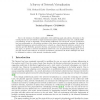Free Online Productivity Tools
i2Speak
i2Symbol
i2OCR
iTex2Img
iWeb2Print
iWeb2Shot
i2Type
iPdf2Split
iPdf2Merge
i2Bopomofo
i2Arabic
i2Style
i2Image
i2PDF
iLatex2Rtf
Sci2ools
CN
2010
2010
A survey of network virtualization
Due to the existence of multiple stakeholders with conflicting goals and policies, alterations to the existing Internet are now limited to simple incremental updates; deployment of any new, radically different technology is next to impossible. To fend off this ossification once and for all, network virtualization has been propounded as a diversifying attribute of the future inter-networking paradigm. By allowing multiple heterogeneous network architectures to cohabit on a shared physical substrate, network virtualization provides flexibility, promotes diversity, and promises security and increased manageability. In this paper, we present a network virtualization model with a set of quintessential design goals, survey the past and the state-of-the-art of network virtualization, and discuss the future challenges that must be addressed to realize a viable network virtualization model.
CN 2010 | Future Inter-networking Paradigm | Network Virtualization | Network Virtualization Model |
Related Content
| Added | 09 Dec 2010 |
| Updated | 09 Dec 2010 |
| Type | Journal |
| Year | 2010 |
| Where | CN |
| Authors | N. M. Mosharaf Kabir Chowdhury, Raouf Boutaba |
Comments (0)

